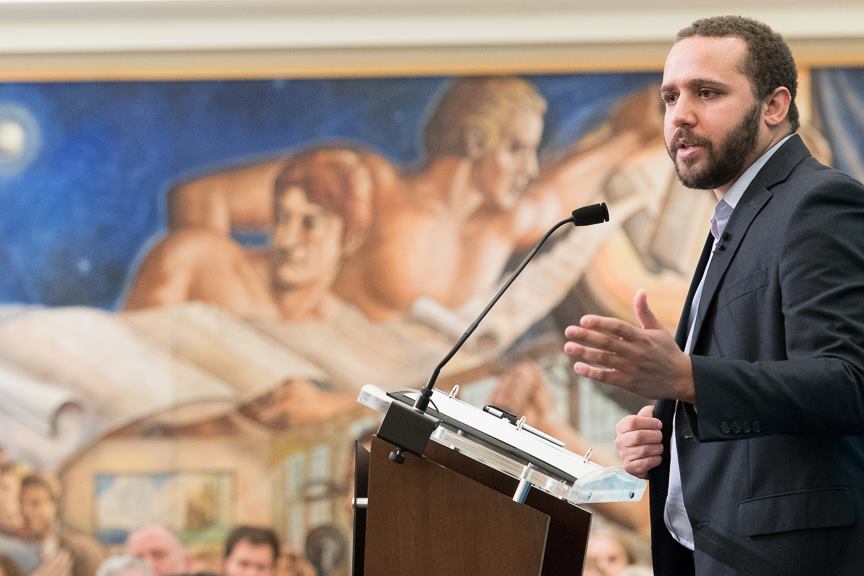Thanks to Wesley Lowery and his colleagues at the Washington Post, citizens anywhere can click on the newspaper’s “Fatal Force” webpage and see the running tally of people who have been shot and killed by police this year.
When Lowery, 27, returned to his hometown September 22, he looked up the number on his phone to answer a question at the City Club of Cleveland: 714. Less than a week later, it had ticked up to 730.
Last year the total was 992 and in 2015, when Lowery and his team won a Pulitzer for creating the database from scratch, it was 963. Despite heightened awareness around police shootings, despite the protests of Black Lives Matter, the number dying is steady. It is tracking to come in again close to a 1,000 deaths this year, Lowery said.
“It’s a pace of about three a day,” he told a sold-out crowd. “What is difficult is fatal police shootings are a relatively random event. Every year, you have police departments that have their first fatal shooting ever. It’s not a set of 12 departments doing most of the fatal shootings . . . You have very few departments that have double-digits.”
And with more than 19,000 U.S. police jurisdictions, a lesson learned about police use of deadly force doesn’t travel, Lowery said. He gave this example: when the New York City police discovered in 1973 that forbidding its force from shooting at moving cars cut citizen fatalities in half, that was good news for New York, but it didn’t disseminate.
Lowery, a self-effacing man who decided in a Shaker Heights middle-school that he wanted to become a journalist, drew strong reviews for his first book They Can’t Kill Us All: Ferguson, Baltimore and A New Era in America’s Racial Justice Movement. Critic Dwight Garner of the New York Times wrote, “This book is electric, because it is so well reported, so plainly told and so evidently the work of a man who has not grown a callus on his heart.”
Lowery described his baptism into covering “policing and race” as accidental, dating to a spot decision by a Washington Post editor who sent him to St. Louis in the aftermath of August 9, 2014, when Ferguson Police Officer Darren Wilson shot and killed Michael Brown.
“I thought this was going to be a very quick story,” Lowery said. “I’d covered police shootings before and I knew the appetite was small. I’d write a story and people would likely move on.”
Instead, Lowery discovered a crowd of perhaps 150 waiting milling in a church parking lot while some 800 people packed inside for a hastily called NAACP news conference. He started in with what he now characterizes as “quaint, naïve questions” asking residents to describe their relationship with police.
“What I’m hearing back are stories that are horrifying: stories of nights spent in jail for unpaid parking tickets; stories of people calling the police for help and ending up in handcuffs,” Lowery said. And even as he is listening, he is editing, discarding anecdotes as unprovable, weighing others with skepticism.
Back in D.C., Lowery and his colleagues went looking for data on police shootings and discovered no entity took responsibility to gather them. The best they could scavenge was a squishy FBI estimate of 463 killed per year, a number the bureau knew was a gross undercount.
“In a country that is obsessed with quantifying and counting, we had no accurate account of how often people were getting killed by police officers,” he said. “But we can tell you exactly how many people saw the movie ‘Get Out’ in Shaker Square and how many bought popcorn.”
The Post decided to track fatal force by looking for media hits, reasoning that on most occasions of lethal police killings a reporter would have filed one story. The team discovered that a quarter of the cases involve mental illness: “Our society solution to mental breakdown is to insert someone with a gun,” Lowery said.
Asked by the lawyer for Tamir Rice’s family about the paucity of convictions of police, Lowery was blunt: “We allow police to kill people when they get scared. Period.”
The Post’s examination of prosecutions found them exceedingly rare, and convictions close to nonexistent. Lowery recommended Jill Leovy’s groundbreaking 2015 book, Ghettoside: A True Story of Murder in America, as one key to pondering these complexities. He also likes Chris Hayes’ A Colony in a Nation, which published in March.
The reporter reflected back on his own incredulity during those first days in St. Louis. “I think if there is a lesson to this work,” he said, “it is we have to listen to our own communities when they tell us stories about the pain and the trauma they are in.”
The chestnut about journalists speaking for the voiceless also began to ring hollow, thanks to an activist who chastened Lowery: “There are no voiceless people,” he said. “There are only people who are unheard.”
